At EMI, our business unit Security offers testing procedures which quantify and evaluate the mechanical and thermal behavior of constructional and geological materials under extreme loads and prepare them for certification. The loads range from quasistatic up to high-dynamic loads.
Equipment
Tabbed contents
Testing facilities
- Open-area test site for explosions and indoor detonation chamber
- Shock-tube facility for blast simulation and research (BlastStar)
- Universal testing machines
- Servohydraulic testing facilities
- Drop-weight facilities
- Hopkinson bar permitting pressure, tensile (spallation) and shear loading configuration with and without pressure chamber for triaxial static output voltage condition
- Climatic chambers
High-temperature furnaces
High-Speed measurement techniques
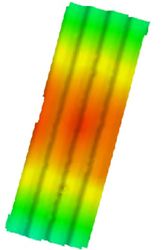
- High-speed cameras
- Acceleration sensors
- Pressure and strain measurement techniques for dynamic loads
- High-speed video systems
- Digital image correlation (DIC) systems in 2D and 3D
- VISAR (velocity interferometer)
- Ultrasonics
- Optical microscopy
- Acoustic microscopy
- Scanning electron microscope (SEM)
Simulation and computation software
- ANSYS Autodyn
- LS-DYNA
- ABAQUS
- SOFiSTik
- APOLLO (computation software developed at EMI)
- SOPHIA (computation software developed at EMI)
- MaATLAB Simulink
- COMSOL
- Hazard analysis – FTA – FMEA
Shock-tube facility BlastStar
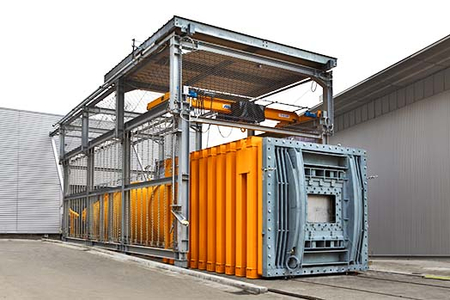
Fraunhofer EMI offers advisory and research services to manufacturers, designers, insurance companies and owners of buildings classified as critical infrastructure and helps to evaluate buildings and their components with regard to pressure shock loads. Our shock-tube facility BlastStar simulates shock loadings caused by detonations or gas explosions. We conduct tests for security glazing in accordance with current standards, which describe the testing procedures and classification. Without the classification part, these procedures are also applicable to other construction components with different materials.
Shock-tube facility BlastStar
Video: functional principle of the shock-tube facility BlastStar.
At EMI’s shock-tube facility BlastStar, we can produce a blast wave that corresponds exatcly to a pressure wave created by explosion.
For this purpose, the high-pressure compartment is filled with air before the test. A membrane separates the compartment from the tube. Once the pressure is high enough, the membrane opens in a controlled manner, releasing no fragments. The special form of the shock tube creates a shock wave with identical loading on the specimen at the end of the tube at any location and any time. This is called planar loading.
This loading consists of a pressure and a suction (negative) phase as is tyical for explosions.
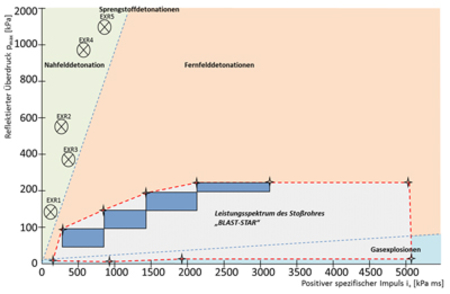
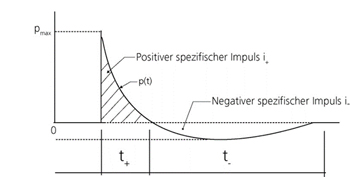
Scope of services:
- Execution of standardized tests to classify the explosion resistance of safety glazing (laminated safety glass, safety windows, safety doors) according to: :
– EN13541:2012 “Glass in building – Security glazing – Testing and classification of resistance against explosion pressure”
– EN13123-1:2001 “Windows, doors and shutters – Explosion resistance; Requirements and classification – Part 1: Shock tube”
– EN13124-1:2001 “Windows, doors and shutters – Explosion resistance; Requirements and classification – Part 1: Shock tube”
– ISO16934:2007 “Glass in Building – Explosion-resistant security glazing – Test and classification by shock-tube loading”
– And more international standards (GSA, ASTM F, 1624-04)
- Analysis of the explosion resistance with variable loading parameters pmax, i+ based on each client’s specification
- Analysis of the blast resistance in case of gas explosions with loading parameters based on each client’s specification
- Analysis of the blast resistance of building structures made of concrete, masonry, glass and lightweight materials
- Analysis of the blast resistance in combination with static over- or underpressure
Pressure shock waves are characterized by a high peak overpressure (pmax), a positive pressure time (t+) and a positive specific impulse (i+). Figure 3 shows an idealized pressure-time curve, which is defined in EN13123-1.
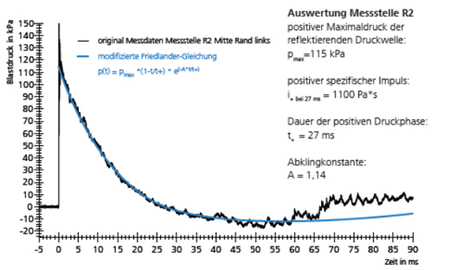
Advantages of the EMI shock-tube BlastStar operated by compressed air:
- High variability in producing loads: tests are possible for all ERP classes (detonations of explosives) and gas explosion (Figure 2)
- Test elements are loaded by a planar shock front (similar pressure-time curve at every part of the element)
- Undisturbed use of sensitive measurement technology (as under laboratory conditions) is possible
- Possibility of attaining a high variability in the dimensions of test elements (maximum 2900 mm * 2900 mm)
- No flow effects (as in free-field tests) due to the execution of the tests at a closed shock tube according to standardized guidelines
- Extensively high reproducibility of loading parameters with little scattering; shock front depends neither on shape nor mass of the explosive (Figure 4)
- Possibility to simulate pressure-time curves with multiple reflections
Results of the experimental analysis:
- Classification of building products following national and international standards
- Pressure-time curves at different measuring points at the specimen
- Deflection measurement at selected points of the test element and derivation of destruction characteristics for further analytical evaluations of the resistance behavior of elements under variable pressure shock loads
- High-speed video recording to analyze the behavior of building components during loading
- Strain measurements (monoaxial and multiaxial) at selected points of the specimen
- Damage analysis and derivation of failure mechanisms
